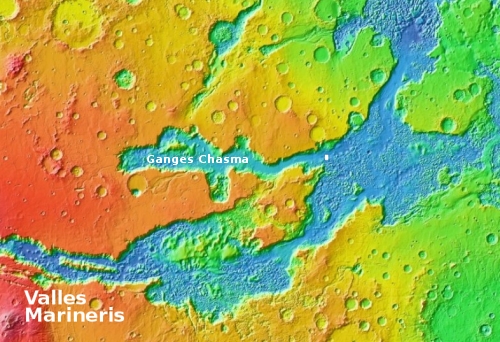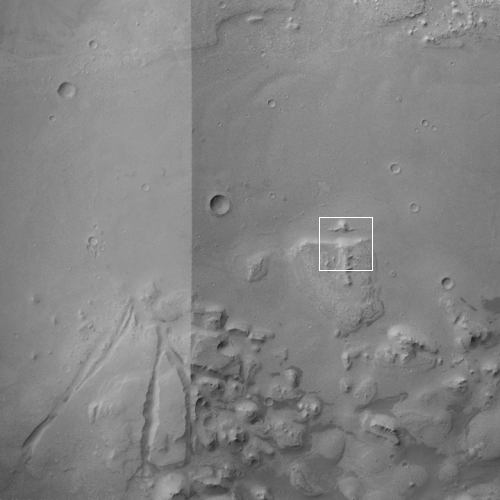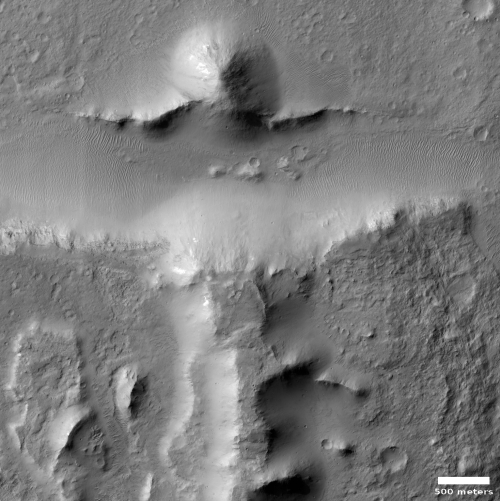An example why scientists think there were catastrophic floods on Mars
Today’s cool image provides a nice illustration why scientists have long assumed that in the distance past there had been catastrophic floods of liquid water on Mars. The photo to the right, rotated, cropped, and reduced to post here, was taken on July 6, 2021 by the high resolution camera on Mars Reconnaissance Orbiter (MRO). It shows an east-west gully cutting between mesas to the north and south.
Because the highest mesas seem to be aligned, this suggests they were once part of the same formation, and something came along to carve that gap and gully between them.
What made the break? The overview map below as usual provides some context, which also provides a possible explanation.


For full images go here and here.
The small white rectangle on the overview map to the right marks the location of these mesas, at the exit from Ganges Chasma, one of the large side canyons that form the gigantic canyon system on Mars dubbed Valles Marineris.
The second image below is a mosaic made from two MRO context camera photos, with the white box marking the area covered by the first image above.
To our Earth-based eyes, all the images from Mars since the first planetary probes have suggested that the canyons of Valles Marineris were quickly carved by big sudden floods of water, flowing from the high Tharsis Bulge volcanic region in the west downhill to exit into the northern lowlands north and east of this location. In the case of these specific mesas, the impression is that something quickly pushed through to cut that gap between the north and south mesas.
This location also happens to be at the edge of what some scientists believe was an intermittent sea at the resurgence from Valles Marineris. That sea created the chaos terrain visible in the southern half of the context camera mosaic. This chaotic region of mesas and cross-cutting canyons extends considerably to the south and east, and is where that theorized ocean is believed to have mostly existed.
The problem with this explanation of catastrophic floods is that no one has yet come up with a model of the early Martian climate that satisfactorily provides conditions where liquid water could have existed on the surface. Other data all suggests the atmosphere was always too thin and cold for liquid water to flow.
The many images from MRO and other orbiters in the past decade have instead raised the possibility that such canyon carving might have been done by either ice or lava. Though this location is in the equatorial regions where no surface or near surface ice has been found, in earlier epochs on Mars things could have been different. Maybe ice glaciers flowed down these giant canyons, carving them and cutting the gap shown in the first image above.
Other data suggests that lava on Mars flows much faster than on Earth, and can cover large distances in a very short time.
Thus, it is possible, though hardly confirmed, that either ice or lava might have carved these canyons. Maybe fast lava floods coming down from the giant volcanoes in the Tharsis Bulge carved these canyons.
Both are guesses, but each are questions that the planetary scientists who are presently studying Mars are considering with greater interest. Was ice or lava a greater factor in Mars’ surface geology than previous thought? These questions appear to be on the mind of many of the planetary scientists whom I have interviewed in the past few years.
On Christmas Eve 1968 three Americans became the first humans to visit another world. What they did to celebrate was unexpected and profound, and will be remembered throughout all human history. Genesis: the Story of Apollo 8, Robert Zimmerman's classic history of humanity's first journey to another world, tells that story, and it is now available as both an ebook and an audiobook, both with a foreword by Valerie Anders and a new introduction by Robert Zimmerman.
The print edition can be purchased at Amazon or from any other book seller. If you want an autographed copy the price is $60 for the hardback and $45 for the paperback, plus $8 shipping for each. Go here for purchasing details. The ebook is available everywhere for $5.99 (before discount) at amazon, or direct from my ebook publisher, ebookit. If you buy it from ebookit you don't support the big tech companies and the author gets a bigger cut much sooner.
The audiobook is also available at all these vendors, and is also free with a 30-day trial membership to Audible.
"Not simply about one mission, [Genesis] is also the history of America's quest for the moon... Zimmerman has done a masterful job of tying disparate events together into a solid account of one of America's greatest human triumphs."--San Antonio Express-News
Today’s cool image provides a nice illustration why scientists have long assumed that in the distance past there had been catastrophic floods of liquid water on Mars. The photo to the right, rotated, cropped, and reduced to post here, was taken on July 6, 2021 by the high resolution camera on Mars Reconnaissance Orbiter (MRO). It shows an east-west gully cutting between mesas to the north and south.
Because the highest mesas seem to be aligned, this suggests they were once part of the same formation, and something came along to carve that gap and gully between them.
What made the break? The overview map below as usual provides some context, which also provides a possible explanation.


For full images go here and here.
The small white rectangle on the overview map to the right marks the location of these mesas, at the exit from Ganges Chasma, one of the large side canyons that form the gigantic canyon system on Mars dubbed Valles Marineris.
The second image below is a mosaic made from two MRO context camera photos, with the white box marking the area covered by the first image above.
To our Earth-based eyes, all the images from Mars since the first planetary probes have suggested that the canyons of Valles Marineris were quickly carved by big sudden floods of water, flowing from the high Tharsis Bulge volcanic region in the west downhill to exit into the northern lowlands north and east of this location. In the case of these specific mesas, the impression is that something quickly pushed through to cut that gap between the north and south mesas.
This location also happens to be at the edge of what some scientists believe was an intermittent sea at the resurgence from Valles Marineris. That sea created the chaos terrain visible in the southern half of the context camera mosaic. This chaotic region of mesas and cross-cutting canyons extends considerably to the south and east, and is where that theorized ocean is believed to have mostly existed.
The problem with this explanation of catastrophic floods is that no one has yet come up with a model of the early Martian climate that satisfactorily provides conditions where liquid water could have existed on the surface. Other data all suggests the atmosphere was always too thin and cold for liquid water to flow.
The many images from MRO and other orbiters in the past decade have instead raised the possibility that such canyon carving might have been done by either ice or lava. Though this location is in the equatorial regions where no surface or near surface ice has been found, in earlier epochs on Mars things could have been different. Maybe ice glaciers flowed down these giant canyons, carving them and cutting the gap shown in the first image above.
Other data suggests that lava on Mars flows much faster than on Earth, and can cover large distances in a very short time.
Thus, it is possible, though hardly confirmed, that either ice or lava might have carved these canyons. Maybe fast lava floods coming down from the giant volcanoes in the Tharsis Bulge carved these canyons.
Both are guesses, but each are questions that the planetary scientists who are presently studying Mars are considering with greater interest. Was ice or lava a greater factor in Mars’ surface geology than previous thought? These questions appear to be on the mind of many of the planetary scientists whom I have interviewed in the past few years.
On Christmas Eve 1968 three Americans became the first humans to visit another world. What they did to celebrate was unexpected and profound, and will be remembered throughout all human history. Genesis: the Story of Apollo 8, Robert Zimmerman's classic history of humanity's first journey to another world, tells that story, and it is now available as both an ebook and an audiobook, both with a foreword by Valerie Anders and a new introduction by Robert Zimmerman.
The print edition can be purchased at Amazon or from any other book seller. If you want an autographed copy the price is $60 for the hardback and $45 for the paperback, plus $8 shipping for each. Go here for purchasing details. The ebook is available everywhere for $5.99 (before discount) at amazon, or direct from my ebook publisher, ebookit. If you buy it from ebookit you don't support the big tech companies and the author gets a bigger cut much sooner.
The audiobook is also available at all these vendors, and is also free with a 30-day trial membership to Audible.
"Not simply about one mission, [Genesis] is also the history of America's quest for the moon... Zimmerman has done a masterful job of tying disparate events together into a solid account of one of America's greatest human triumphs."--San Antonio Express-News



“catastrophic” floods
It’s just fortunate no lives were lost.
The martian terrain always looked like catastrophic flooding rather than something like flowing rivers to me.
My own crack pot theory that I offer no proof of (I’m a government scientist at heart)- Mars had a lot of water but was frozen like the snowball earth. The flood events were caused by large impactors. There might be a crater in rock buried under the flood terrain. The water would rapidly freeze and then maybe sublimate away. Mars was never able to erode the canyons away like similar events on early earth.
Andrew_W observed: “It’s just fortunate no lives were lost.”
We don’t know that. Maybe.
John-
Your crack-pot theory, sounds (a whole lot) better than some of these PhD-inspired theories I’ve heard.
[not to totally discredit myself —you ever heard of Graham Hancock?}
Blair-
That, is hilarious!